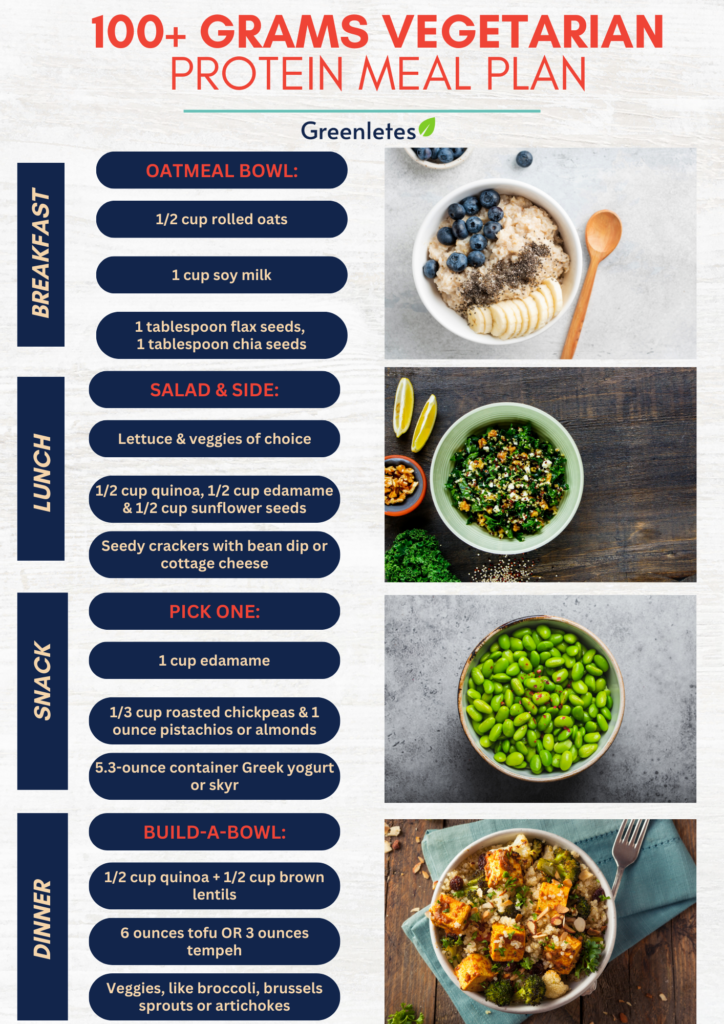Protein is an important macronutrient that helps keep you full, contributes to muscle growth and aids in weight loss efforts. If you don’t eat enough protein, you may feel extra hungry and crave sugary foods. And without proper planning, you may eat less protein than you need on a vegetarian or vegan diet.
Most active people need at least 1.2 to 1.6 grams per kilogram of body weight (0.54 to 0.72 grams per pound) per day. For a 150-pound person, that’s about 80 to 100 grams of protein per day. So how the heck do you eat that much vegetarian protein daily?
I’ve been a vegetarian for 10+ years, and I’ve worked with hundreds of plant-based athletes. Getting enough protein is doable and not as difficult as you may think.
This article discusses the best sources of meatless protein and how to get over 100 grams of vegetarian protein in a single day.
How can a vegetarian get protein?
There are many sources of proteins for vegetarians. Let’s break them down into five groups:
Dairy and eggs
Unlike a vegan diet, vegetarians eat dairy products and eggs. This includes Greek yogurt, which has roughly 15 grams of protein per ½ cup, as well as milk and cheese. A cheese stick has about 7 grams of protein, and one large egg has 6 grams of protein.
Dairy is an excellent source of calcium and Vitamin D, and eggs have Vitamin D and Vitamin B12. These nutrients are more difficult to get from plant-based sources, so many vegetarians eat dairy and eggs to fill the nutrient gaps.
Beans and legumes
This category of foods offers the most variety, affordability and convenience. Most canned beans have around 6 to 8 grams of protein per ½ cup. Legumes are similar to beans and include lentils, chickpeas, fava beans and more.
Here are some of the most common varieties of beans and legumes:
- Black beans
- Kidney beans
- Great northern beans
- Cannelini beans
- Chickpeas
- Black eyed peas
- Fava beans
- Butter beans
- Brown lentils
- Red lentils
- Peas
- Adzuki beans
- Pinto beans
- Green beans
- Edamame beans
- Mung bean
Soy products
Soy foods, like tofu, tempeh and edamame, are high in plant-based protein. Three ounces of tofu has 9 grams of protein and 3 ounces of tempeh has a whopping 18 grams of protein. Edamame is a soybean that is also packed with protein.
Soy products are rich in plant-based calcium, making them a great stand-in for dairy products. And tempeh is a fermented soybean, meaning that it also has gut-healthy probiotics.
Nuts and seeds
Although nuts and seeds are richer in fat than protein, they still have some protein. For example, one ounce of pistachios or almonds has 6 grams of protein. In addition, one-ounce of pumpkin seeds has 8 grams of protein.
Nuts and seeds come in many varieties and make a great topping to a dish for added crunch, protein, healthy fat and texture. Here are some of the most common types:
- Almonds
- Pistachios
- Walnuts
- Pecans
- Hazelnuts
- Brazil nuts
- Sunflower seeds
- Pumpkin seeds
- Chia seeds
- Flax seeds
- Hemp seeds
Other
Some sources of vegetarian protein don’t fit neatly into the other categories. Seitan, for instance, is a textured wheat that mimics the consistency of meat and has 15 grams of protein in 3 ounces. Some meat substitutes, like Beyond or Impossible Burgers, or generic faux chicken nuggets, also have plenty of protein. But they are usually high in saturated fat, so eat them sparingly.
Lastly, protein powders and bars are also good sources of vegetarian protein. You get more nutrients from the whole foods on this list than the processed “others”, so eat these convenient foods sparingly.
Vegetarian Meal Plan with 100+ grams of protein
Now that you know all the top vegetarian protein sources, you may be wondering how to put these together to reach the recommended daily allotment. Below is a sample meal plan for a vegetarian day of eating with 100 grams of protein

Breakfast
Protein: 22 grams
Amp up the protein on a simple bowl of oatmeal.
Start with ½ cup of rolled oats, add 1 cup of soymilk, 1 tablespoon of flax seed, 1 tablespoon of chia seed and your favorite fruit. Microwave for 1 minute and enjoy!
To add another 4 grams of protein, top it with a spoon of peanut butter!
Lunch
Protein: 30 grams
You may think of a salad as low in protein, but this one has the right protein-packed plant-based ingredients.
Combine kale with shredded carrots, ½ cup edamame, ½ cup quinoa and ¼ cup pumpkin seeds and top with your favorite dressing for 20 grams.
On the side, eat seedy crackers with cottage cheese or a bean dip for 10+ more grams of protein.
Snack
Protein: 15 grams
Feeling hungry in between meals? Reach for one of these protein-packed snacks.
- Greek yogurt- siggis 16 grams
- 1 cup edamame
- ⅓ cup roasted chickpeas + 1 ounce pistachios or almonds
Dinner
Protein: 35 grams
Customize a protein-packed bowl to suit your tastebuds.
Mix ½ cup lentil with ½ cup of quinoa. Top it with 6 ounces of tofu or 3 ounces of tempeh, and use your favorite marinade to add flavor. Add some protein-rich veggies, like broccoli, cauliflower, Brussels sprouts or artichokes. Then sprinkle on some hemp seeds or sliced almonds for texture.
Which vegetarian food has the highest amount of protein?
Soy foods, like tofu, tempeh, edamame and soy milk, are highest in protein. Use these whenever your plant-based meal needs a protein boost.
Which veggie has the most protein?
Believe it or not, some veggies have protein. Broccoli, artichokes, potatoes, asparagus, and corn have about 2 to 3 grams of protein per serving. When combining plant-based protein sources, every single gram counts!


0 Comments